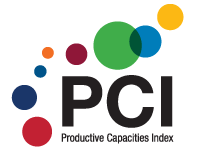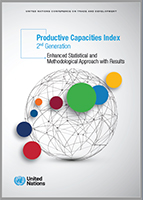Productive Capacities Index

UNCTAD’s Productive Capacities Index is a dynamic and practical tool to support developing countries in understanding the status of their productive capacity and how this can be improved.
It builds on UNCTAD’s long-standing work on productive capacities, which are essential for generating inclusive and sustained economic growth and achieving sustainable development.
The PCI covers 195 economies for the period 2000-2024. The set of productive capacities and their specific combinations are mapped across 43 indicators. This makes the PCI multidimensional in its analytical abilities.
The PCI can help diagnose the areas where countries may be leading or falling behind, spotlighting where policies are working and where corrective efforts are needed. It suggests a roadmap for future policy actions and interventions under each of its eight categories: human capital, natural capital, energy, ICTs, structural change, transport, institutions and the private sector.
The PCI was developed in response to a resolution by the United Nations Economic and Social Council (ECOSOC), (E/RES/2017/29), encouraging UNCTAD “to pursue its methodological work to measure progress in and identify obstacles to the development of productive capacities in developing countries”.
UNCTAD established a Statistical and Technical Advisory Group (STAG) to ensure the index's methodological rigour and integrity with the evolving statistical methods, quality and standards. STAG consists of notable academics in the field, national statisticians, and statisticians and econometricians from UN and non-UN international organisations. The PCI is also supported by a High-Level Advisory Board (HLAB) that guides UNCTAD’s Secretary-General on related research and policy matters. The PCI is also subject to peer reviews from other statisticians and academics outside the STAG.
UNCTAD provides regular training to stakeholders in selected countries on the application of the PCI in development policymaking. Countries interested in participating in these training sessions are invited to submit a request.
What are productive capacities?
UNCTAD has long defined productive capacities as “the productive resources, entrepreneurial capabilities and production linkages, which together determine the capacity of a country to produce goods and services and enable it to grow and develop.”
- Productive resources are factors of production, including different types of productive resources and capital. They include financial capital and physical capital, the latter comprising both machinery and equipment (typically operating at the firm / farm level) and infrastructure.
- Entrepreneurial capabilities are the skills, knowledge, and information which enterprises have. They comprise entrepreneurship, entrepreneurial capabilities, and technological capabilities. They include the important skills required for investment, production and establishing linkages at the firm / farm level.
- Production linkages are flows among productive units (firms / farms) of goods and services, knowledge, technology and information, and productive resources, including human resources). They include exchanges among productive units of different sizes (micro, small and medium-sized enterprises and large ones), and ownership structures (domestic / foreign, public / private), operating in different sectors.
What role do productive capacities play?
Developing productive capacities, plays a central role in setting in motion the long-term process of structural transformation, which is the backbone of sustainable development. The available evidence shows no nation has developed without fostering productive capacities and structural economic transformation.
Building the economic resilience of developing countries remains a daunting challenge. It depends fundamentally on creating, maintaining and using productive capacities to realize development objectives. This requires a shift from the current fragmented and project-based interventions towards coherent, economy-wide and programme-based approaches to removing binding constraints on development. Actions and interventions at the domestic level need to be supported and complemented by additional robust international support.
The PCI makes an important contribution to these efforts. The index draws on decades of extensive research and policy analysis work, as well as lessons learned from UNCTAD’s technical support to the most vulnerable countries in developing key aspects of their trade and productive structures.
The index is the first comprehensive attempt to measure productive capacities in all economies and construct a multidimensional tool that can provide country-specific insights and diagnostics of productive capacity development.
PCI and its categories
The overall index summarises the state of productive capacities in economies worldwide by computing scores that range between 0 and 100 (boundaries not included).
The PCI also offers country scores to help in understanding the sources of systemic vulnerabilities and identifying the enablers of economic growth, including progress towards national and global development targets.
For statistical and measurement purposes, the overall PCI index is further broken down into the following eight categories: human capital, natural capital, energy, transport, information and communication technologies (ICTs), institutions, private sector and structural change.
 Human capital
Human capitalHuman capital encompasses the education, skills, and health of the population, as well as the integration of research and development into society. It supports individual productivity, societal innovation, and structural transformation, driving long-term development and competitiveness.
 Natural capital
Natural capitalNatural capital includes a country’s extractive and agricultural resources and the rents they generate. It shapes development paths, influences structural transformation, and supports productive diversification, though high dependence on commodities can create economic volatility if resources are not managed strategically.
 Energy
EnergyEnergy underpins all economic and social activity by enabling production, investment, and innovation. Reliable and affordable supply supports industrialization and technological progress, while shortages hinder growth and stability. It drives structural transformation and determines how firms and households adopt modern technologies and join wider value chains.
 Transport
TransportTransport infrastructure underpins productive capacities by ensuring the efficient flow of people, goods, and information. Reliable networks lower costs, expand markets, and connect regions, driving structural transformation and cohesion. They also spread knowledge and innovation by linking firms and consumers. The PCI captures capacity and use across road, rail, air, and maritime transport.
 Information and Communication Technology (ICT)
Information and Communication Technology (ICT)ICTs are key to modern infrastructure, driving the flow of ideas, data, and innovation. They foster structural transformation by spreading technology, creating new sectors, and improving productivity. ICTs also reduce information gaps, enhance inclusion and connectivity, and the PCI measures their capacity through access and usage indicators.
 Institutions
InstitutionsInstitutions provide the framework for economic decision-making and are central to sustainable development and transformation. They shape laws, regulations, and governance that enable markets, protect rights, and ensure effective policies. Strong institutions lower uncertainty and costs, encourage investment and innovation, and, within productive capacities, sustain planning, stability, and accountability.
 Private sector
Private sectorPrivate sector development is central to building productive capacities by driving investment, innovation, and job creation. A dynamic and diverse private sector promotes entrepreneurship, strengthens industrial linkages, and supports structural transformation. Its role in the PCI highlights its contribution to resource mobilization, production, and sustained economic growth.
 Structural Change
Structural ChangeStructural change represents the shift of resources toward higher-productivity activities, both driving and resulting from productive capacity development. It reflects economic transformation from agriculture to industry and services or toward more technology-intensive production. This evolution creates a virtuous cycle of productivity, competitiveness, and investment, continually sustaining growth and upgrading over time.
Data Sources and Approach
The PCI data are drawn from a variety of internationally comparable and rigorous data sources, including UNCTADstat, the World Bank, the World Health Organization, UNESCO, the OECD, the International Telecommunications Union, International Civil Aviation Authority, UNEP, and many others.
The PCI, now in its third generation, was constructed in accordance with rigorous, internationally recognized statistical and econometric methodologies for developing a composite index, under the oversight of the STAG. This latest iteration incorporates extensive feedback from users worldwide, including country-level statistical training sessions and national productive capacities gap assessment workshops, which are part of UNCTAD’s programme on fostering productive capacities.
As with any composite index and all statistical indicators, there are limitations to the PCI. Above all, the PCI scores are ultimately a reflection of the accuracy and availability of the internationally reported data used as input. The available input data are limited for certain indicators and for some countries.
The results are also dependent on the methodology used and the assumptions made. The PCI’s value lies in its aptness, methodological rigour and robustness, as a pointer that enables national decision makers to gain a sense of the current state of productive capacities.
More on the PCI methodology will be available in the forthcoming Productive Capacities Index: 3nd Generation - Enhanced Statistical and Methodological Approach with Results.
PCI publicatons
PCI visualization
The interactive maps presented below have been designed to help users explore PCI data over time and space. Visualizing data spatially is a critical tool for revealing geographical patterns. The PCI results presented cover 195 economies over the period 2000–2024.
Measuring and benchmarking productive capacities globally reveals significant gaps, not only between developed and developing economies, but also among developing countries themselves. The Productive Capacities Index demonstrates that differences in socio-economic development across countries and regions are a consequence of gaps in their productive capacities.
Structurally weak and vulnerable economies, including the least developed countries (LDCs) and landlocked developing countries (LLDCs) perform particularly poorly on PCI.
World map - PCI overall and component indices
Notes: This map presents the world as configured today. As the dataset begins with the year 2000 it must, by necessity, incorporate several geopolitical developments and changes that have occurred over the subsequent 20 years.
The performance of small island developing States (SIDS) must be understood in the context of their unique geographical and structural characteristics. Due to statistical effects linked to their small populations and land areas, small island developing States may appear to perform better on indicators measured relative to population or geography.
Regional maps - PCI overall and component indices
Average overall PCI scores for all economic groups improved in 2000–2024, although to varying degrees. However, there are significant gaps in the average scores observed across and between the different groups. With regard to LDCs and LLDCs, their overall PCI scores was driven by their high levels of natural capital, which entrenches increased commodity dependence rather than facilitating economic diversification or structural transformation. Overall trends also show communality among all groups, namely, a steeper rise in the first half of the period and a more moderate increase in the second half.
Notes: This map presents the world as configured today. As the dataset begins with the year 2000 it must, by necessity, incorporate a number of geopolitical developments and changes that have occurred over the subsequent 20 years.
The performance of small island developing States (SIDS) must be understood in the context of their unique geographical and structural characteristics. Due to statistical effects linked to their small populations and land areas, small island developing States may appear to perform better on indicators measured relative to population or geography.


 Productive Capacities Index: 2nd Generation - Enhanced Statistical and Methodological Approach with Results
Productive Capacities Index: 2nd Generation - Enhanced Statistical and Methodological Approach with Results
